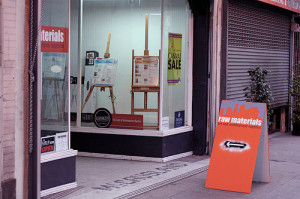Farnoosh Torabi's Blog, page 27
October 2, 2013
Best Home Hair Color Treatments Under $10
Coloring your own hair can save you time and money, but is it possible to achieve salon-quality results at home? Read more here.
Share with us your home hair treatment tips. Connect with me on twitter @Farnoosh and use the hashtag #finfit.

September 30, 2013
Financial Skinny: Obamacare Exchanges
 New federal health insurance exchanges, the main component of President Obama’s Affordable Care Act (or Obamacare,) are planned to launch tomorrow, Tuesday Oct. 1. While the policy has been a hot topic since its passage in 2010, how much do you know about the exchanges and how to enroll?
New federal health insurance exchanges, the main component of President Obama’s Affordable Care Act (or Obamacare,) are planned to launch tomorrow, Tuesday Oct. 1. While the policy has been a hot topic since its passage in 2010, how much do you know about the exchanges and how to enroll?
“On Tuesday, about 40 million more Americans will be able to finally buy quality, affordable health care, just like anybody else,” Obama said on Friday. The new health insurance exchanges, he said, “will be open for business on Tuesday no matter what — even if there’s a government shutdown. That’s a done deal.”
These healthcare exchanges are the first big step in Obamacare’s efforts. They are, in effect, online marketplaces where Americans can enter their information to search and compare health care options in their states. Also, by opting into the system, some consumers can become eligible for subsidies to help pay for the cost of health insurance – depending on their income. The idea behind is that care becomes more affordable when more Americans are in the marketplace and can shop fairly. So, like Expedia.com for travel or Hotels.com for lodging, the exchanges are designed to be a one-stop shop to apply for health coverage, compare options, and enroll in a plan.
Again, the enrollment period begins October 1 and runs through March 31 but plans bought through the exchanges won’t start until January 1. Now, according to the law, by 2014 every American will have to have some form of health insurance or be fined. Those covered by their employers, Medicare or Medicaid aren’t obligated to do anything. But, for everyone else, Obamacare’s exchanges are the first step to getting covered.
While Obamacare is a pretty complicated law, it’s fairly simple to enroll. Here are the four steps:
1. Create an account – Begin by visiting Healthcare.gov to set up an account. You’ll be asked to provide some pretty basic information for the site. Then, choose a user name, password and set security questions. Your account will be ready to go.
2. Apply for Marketplace coverage – Next, you’ll begin applying for coverage by entering some information about you and your family (those you want covered.) To determine the plans that fits you and your eligibility for a subsidy, you’ll need to provide your income, household size, and other information.
3. Pick a plan – Using that, the exchange will pull up all the health insurance plans and programs you’re eligible for and compare them side-by-side. You’ll also find out if you ‘re eligible for a subsidy and exactly how much.
4. Enroll – Finally, you enroll when you have a plan that best fits your needs. Coverage will start as soon as January 1, 2014.
If you need help with your application, you can visit LocalHelp.HealthCare.gov to find a trained specialist in your area. The government has also put together an informational site that’s pretty easy to navigate at healthcare.gov. It lists some of the most common questions about the process and has tons of graphics, calculators and other tools to show how it all works.
Photo Courtesy, Care Medical Tourism.

September 29, 2013
Art Supplier Sticks to Your Budget
 When the street artist who lives around the corner from Raw Materials LA was low on cash recently, co-owner Celia Winstead did what she would do for any of her customers and made it work.
When the street artist who lives around the corner from Raw Materials LA was low on cash recently, co-owner Celia Winstead did what she would do for any of her customers and made it work.
“He’s a Vietnam vet, mentally ill, homeless,” she says. “He’s also a loyal customer and extremely talented. We love his work.”
Like other successful businesses in the “new” Downtown Los Angeles, Winstead caters to a wildly diverse market of artists, many with a limited income. “We carry a good-better-best product mix in most of our product categories,” she explains. “We want to be able to provide the artist with quality art materials that fit their budget. We don’t want to exclude customers from a category because of price.”
Downtown’s thriving artist community is a microcosm of a $4 billion-dollar-a-year industry spread across 4.4 million active artists that, according to this study by the International Art Materials Association (NAMTA), includes recreational, professional, and student artists. Within these broad market segmentations, however, there are individual artists with needs as varied and ever-changing as art itself. “I’ve seen trends and businesses come and go and we’re determined not to be one of those,” says Winstead. “We pay attention, as residents, as consumers. As Downtown grows, we’ve been able to grow with it.”
While online spending (28%) continues to dominate, the NAMTA study shows that artists prefer to spend their money at independent art supply stores (19%) over larger chains (17%). “People often go into independent art stores expecting the price points to be high. They also expect a certain level of customer service that you wouldn’t find at a chain store,” says Winstead. “But it doesn’t have to be one or the other. Our pricing is very competitive with a lot of stores, both independent and chain.” Raw Materials also offers convenient online shopping, as well.
Winstead moved Downtown more than twenty years ago – long before it was trendy – to escape the hollowness of a career in theatrical marketing and digital media consulting. Raw Materials LA represents a clean break allows her to focus on her real ambition: filmmaking. She credits her understanding both of Downtown’s cultural fabric and of the artist’s mindset for enduring where other art-minded businesses have failed.
“As an artist, you don’t want anything to suffer because of materials, whether it’s your materials or your actors or your production design. You don’t want to compromise your work,” says Winstead. “We understand that. I think that makes a difference.”

Surprising Benefits of a AAA Membership
 Auto and travel membership clubs offer a whole lot more than simple roadside assistance and towing. I pay for a yearly AAA membership and it costs me about $52. I do it for the peace of mind (and yes, I’ve used the subscription for a tire change this year already!). But only recently have I discovered a host of other surprising benefits that automatically come with membership. The sheer number of discounts will make your head spin. However, discounts vary by state so make sure to look up AAA specials in your local area. In the meantime, here’s a sampling of what’s available nationally and in New York:
Auto and travel membership clubs offer a whole lot more than simple roadside assistance and towing. I pay for a yearly AAA membership and it costs me about $52. I do it for the peace of mind (and yes, I’ve used the subscription for a tire change this year already!). But only recently have I discovered a host of other surprising benefits that automatically come with membership. The sheer number of discounts will make your head spin. However, discounts vary by state so make sure to look up AAA specials in your local area. In the meantime, here’s a sampling of what’s available nationally and in New York:
Theme Parks
There are over 200 different discounted tickets for you and your family (amusement parks, shows, admissions) when you log on to AAA’s website, with theme park savings up to 40% off entrance to parks like Disneyworld, Seaworld, Bush Gardens, SplishSplash, Hershey Park, Six Flags, Universal Orlando, and more.
Eyewear
Save 30% at LensCrafters on eye exams and eyecare, 50% off a frame purchase, and 10% off non-disposable contact lenses. And for any sale already going on, members can get an additional $5 off.
Movie Tickets
Save up to 40% on box-office prices at participating movie theaters, plus free shipping (they mail you the tickets). The best deal offered saves you $45 dollars when you buy 10 tickets for $70. This excludes the first two weeks of first-run movies but the good news is that AMC tickets can be also be used at Loews, Cineplex Odeon, Magic Johnson and Star Theaters.
Tax Preparation
Save 25% on tax preparation services through TurboTax Basic plus save $10 off TurboTax Deluxe, or $20 off TurboTax Home & Business.
Prescriptions
The discount is accepted at participating locations, but the site claims this is 9 out of 10 pharmacies, and covers everyone in your family (including your pets!). Save anywhere from 50-24% on generic drugs and an average 15% off name-brand drugs when using the AAA Prescription Savings Program.
Moving
Members save up to 20% on Penske one-way truck rentals with free unlimited mileage, with 12% off moving supplies.
Gifts
You can get a 20% discount on flowers and gift baskets with 1-800-Flowers, and 15% off cookies and treats from Cheryl’s and David’s Cookies.
Direct TV
Direct TV rotates their deals often so check back to see what’s new. At last check the AAA members running now is $200 off (or $10 off for 20 months) for new customers.
Travel
Save $15 with Hertz on a weekend rental, or $50 with a monthly rental. Regional deals galore, such as a free day on a 3-day weekend in California and Florida.
Fall Getaways
You can save on all kinds of Fall excursions such as Canadian cruises, Caribbean vacations – and even 10% off Amtrak tickets. For example, in the northeast, save on participating hotels in Boston, New York, Baltimore and Atlantic City (a 3-star hotel in Atlantic City before November 30th is quoted as low as $45). And booking your flight and hotel together on AAA’s website can save you up to $525.
Electronics
This fall, save an additional $80 on your next Dell purchase of certain PCs or tablets (over $799.99) and also save with free ground shipping.
Photo Courtesy of: commons.wikimedia.org/ Sunday_morning_tire_change

September 26, 2013
Stain-Removing Secrets: Deodorant Stains
We’ve all been there: running late and suddenly catching an unsightly deodorant stain on the way out the door. Don’t despair. These stain-removing secrets will get that out in a jiffy. Read more here.
Connect with me on Twitter @Farnoosh and use the hashtag #finfit.

Free apps to make you healthy and happy
Trying to be healthy and happy? There’s more than one app for that! Read more here.
What apps make you healthy and happy? Connect with me on Twitter @farnoosh and use the hashtag #finfit.

September 24, 2013
My Life in a 190-Square-Foot Apartment
Tiny apartments aren’t just for New Yorkers anymore. Demand for affordable, convenient housing in desirable neighborhoods has given rise to micro-apartments across the country. Read more here.
Would you ever live in a tiny apartment? Connect with me on Twitter @Farnoosh and use the hashtag #finfit.

September 23, 2013
Tips from America’s Smartest Shopper
Each week, Emily Graves creates a spreadsheet comparing the sale prices of common grocery items, sharing it on her blog with her 20,000 readers who use it to shop at a store that price matches. But, her shopping tips don’t stop there. Read more here.
Connect with me on Twitter @Farnoosh and use the hashtag #finfit.

September 22, 2013
Preparing for a Mid-Life Career Change
 Whether it’s mid-career or after retirement, second careers and becoming more and more common. According to AARP, nearly 9 million baby boomers have found second careers, while some 30 million say they would like to make a change. And with a fluctuating job market, many younger workers are also exploring their career options, trying out two or three careers out before they settle down.
Whether it’s mid-career or after retirement, second careers and becoming more and more common. According to AARP, nearly 9 million baby boomers have found second careers, while some 30 million say they would like to make a change. And with a fluctuating job market, many younger workers are also exploring their career options, trying out two or three careers out before they settle down.
Moving from one job to the next – especially one career to the next – is a big step. It’s critical to plan for your second act and to get some insight into how it can be done effectively. I sat down with networking and communications expert Faith McKinney to get her first hand account of what it takes to start over. McKinney is the author of “Schmingling – The Art of Being Well Connected.”
Living in Indianapolis, she had been an employee of the United States Postal Service for 25 years when she decided to begin her second act. McKinney’s job at the post office was “safe,” she says. It was stable, close to home and gave her the necessary income and benefits to support a family.
Nearly three decades in, however, she discovered she wanted more. “I can’t really say I had a career. What I had was a job,” says McKinney. She’d always had an interest in teaching, public speaking and media but McKinney says it wasn’t until her forties that she had the confidence to pursue a career that incorporated the three. After 25 years at the post office, she took stock of her skills, interests, goals and came up with a plan. “I knew I wanted to travel and that I’d have to do that with my family,” says McKinney. “I always loved teaching and sharing with others and I had a passion for connecting people and networking. I had to figure out a career that would allow for my gifts but that also fed my needs.”
With that in mind, McKinney set out to explore her options and discovered that her passion for networking could be captured and marketed. Within Indianapolis, she soon became known as “The Great Connector” for her ability to bring people together to do business. Before long, she was serving as host and lead ambassador for the Successful Thinkers of Indianapolis, a professional networking organization with more than 800 members.
Today, Mckinney has parlayed her work with the Successful Thinkers into a career as an author and successful media personality, sharing her ideas about networking, branding and entrepreneurship. “It’s about creating the life that you want and working towards that,” McKinney says. “For me, the knowhow I needed came from my own studies – webinars and seminars that gave me exposure and knowledge to do the work. And along the way I gathered the skills I needed.” McKinney says the number one thing anyone pursuing a second act should do is reorient themselves to the work world and get brushed up on their chosen industry. She recommends online courses and continuing education programs. “They’re relatively inexpensive and typically very flexible,” says McKinney. “If you’re already an alumni of an institution, that helps and you can find just about anything on the internet.”
If you’re considering going back to school before starting your new career, consider this: Depending on your income, you might qualify for tax credits like the lifetime learning credit, which offers a break of about $2,000 each year for tuition, fees, books and supplies associated with career advancement.
McKinney’s one other tip? Get started as soon as possible. “Nobody gave me permission to get started,” says McKinney. “Sometimes we’re waiting to be in a good place or for life to slow down but don’t let too much time to pass without acting on your dreams. Finances can be the biggest hurdle but pace yourself. But unlike when you were in your twenties, you don’t have to jump right into anything. Make progress bit by bit. Take it slow and watch your career grow.” Photo Courtesy, miriampastor.

September 19, 2013
Pilates Teacher Stretches Towards Better Business

Pilates instructor Rebecca Simons (background) works with a client.
Pilates instructor Rebecca Simons compensates for her lack of formal business experience by stretching dollars and staying focused on her young studio’s core strength: a fiercely loyal roster of clients.
The 33-year-old UCLA grad was starting down a path toward a career in academia before fate (a part-time admin job at a nearby Pilates studio) intervened. “The owner saw me taking one of the classes and asked me if I’d ever thought about teaching,” she remembers. “She spent about 10 minutes showing me about five moves and all of a sudden I was teaching my first class as a sub. I was nervous, sweating, I had little flash cards. It was hilarious.”
Simons quickly developed a core base of devotees by teaching Pilates mat classes at various gyms around Los Angeles. She deferred grad school for a year to focus on her marriage that was on its way out. “That’s when I decided to start teaching Pilates full time,” she explains. “I wanted to become more financially independent in case I got divorced.”
In 2007, sparked in part by a management shakeup at her primary studio, Simons took the ultimate step towards financial freedom and opened Santa Monica-based Blackbird Pilates (522 Wilshire Blvd. Suite D). “I wasn’t really comfortable with the change [in management] and I wanted more of a challenge,” she says. “I thought, ‘You know what… I have all these clients. Why can’t I open up a small studio on my own?’”
Her supportive clients were vital in making the shift happen. “It’s important when you open a studio to open up near where your clients are,” notes Simons. “One of mine, who was in commercial real estate, found an office space for lease in this really funky building and acted as my broker. Another lent me reformer equipment in exchange for some free classes.”
“My clients were all so happy to see me doing something like this that they were very forgiving throughout my transition,” she says.
Her studio was such a hit that when an adjacent space on her floor became available in 2009, Simons jumped at it in a move that proved to be premature. “I don’t get my pride involved in my business,” she explains. “I had made the decision to expand and I bought more equipment but I didn’t feel comfortable. So I put the expansion on hold. I sold the equipment which was so new that I didn’t really lose any money.”
Through ups and downs, Simons understands that client loyalty goes both ways. She weathered the still-recovering economic storm by opening up affordable group classes to keep her middle-class clients afloat, while her wealthier clients helped sustain her business. She maintains that feeling of we’re-in-this-together by holding dogs-and-dinner parties and hiring from within. “My clients are like my family,” she says. “That whole idea of the ‘family business’ is getting lost today. I think people are craving that one-on-one personal attention.”
The old-fashioned formula seems to be working. Just this month, Simons got the keys to that elusive second space. “I’m finally ready,” she says.




